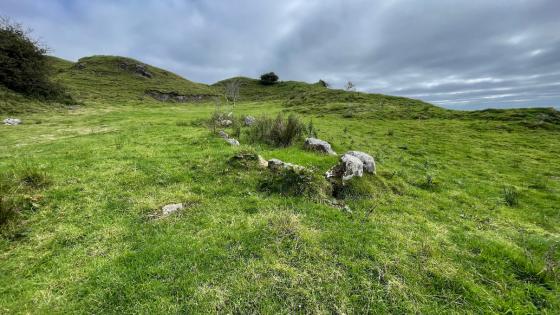
4/5/18

4/5/18

Quite the coolest bullaun stone that there is.

4/5/18

Killinagh bullaun stone being slowly strangled by summer vegetation

8/3/07

With turnstones in situ

With turnstones removed
I was in the area and had to stop by to one of my favourite sites in Ireland. I’d been using Anthony Weir’s Early Ireland – A Field Guide and Estyn Evans’s Prehistoric and Early Christian Ireland – A Guide and both mention that the site is important and may well date back to the mesolithic. Leaving that to one side, this much later stone deserves some sort of care and attention. I hadn’t planned on coming here and wished I’d brought some secateurs. No-one in authority seems to care for these stones. There were offerings in each of the bullauns under the cursing stones. Fair enough – maybe it’s left to us to clean up the site, those who believe that these places are worth looking after. Alas, these stones are on private land and I’m not qualified to caretake them. I wish I lived closer to here.
A truly impressive bullaun stone, nestled in against a field boundary and a stone’s throw away from the shore of Lough Macnean Upper. Park at the modern graveyard 100 metres east from the signpost to Killinagh church and walk back. The stone is past the church and old graveyard down near the shoreline.
There were some ‘offerings’ placed under the turnstones in the bullauns. We cleaned some of the detritus that is moulding away on and around the stone, but brambles have taken hold in the space between the upper surface and the lower.
Perhaps after the two inscribed bullans just noticed, the ten holed example of which I furnish a faithful drawing, is the most remarkable in Ireland. It stands on the shore of Upper Lough Macnean, and close to the ancient ruined parish church of Killinagh. The basins, which average about ten inches in diameter, are of various depths, and each is nearly filled with a somewhat circular or oval stone. There is a holy well close at hand, dedicated, like the church, to St. Brigid. The bullan is populary known as “St. Brigid’s stone,” or altar. A lady, who from infancy has resided in the immediate neighbourhood, was good enough to inform me that she had been told when a child by her old nurse, who was a native of the district, that many years before this curious monument was known amongst the people as the “cursing stone.“*
I heard the same story from a very old man who had lived all his life almost in sight of the time-stained gables of the neglected and mouldering cill. It was the custom, he said, when any of the neighbours bad a grudge against a real or supposed enemy, and wished him harm, to proceed to the “altar” and anathematize him, at the same time turning the stones deposited in the basins. This practise, however, was not carelessly or lightly to be indulged in, as the curses, when undeserved, were sure to descend in full force on the person or property of their utterer.
‘On the Bullàn, or Rock-Basin, as Found in Ireland; With Special Reference to Two Inscribed Examples’ by W. F. Wakeman, in Proceedings of the Royal Irish Academy vol. 1 (1889-91).
* when a child she was not unfrequently brought to the spot by an aged nurse, who there performed devotions of some kind. – same author, ‘On Certain Markings on Rocks, Pillar-Stones, and Other Monuments, Observed Chiefly in the County Fermanagh’, from the Journal fo the Royal Historical and Archaeological Association of Ireland (Jul 1875).















































